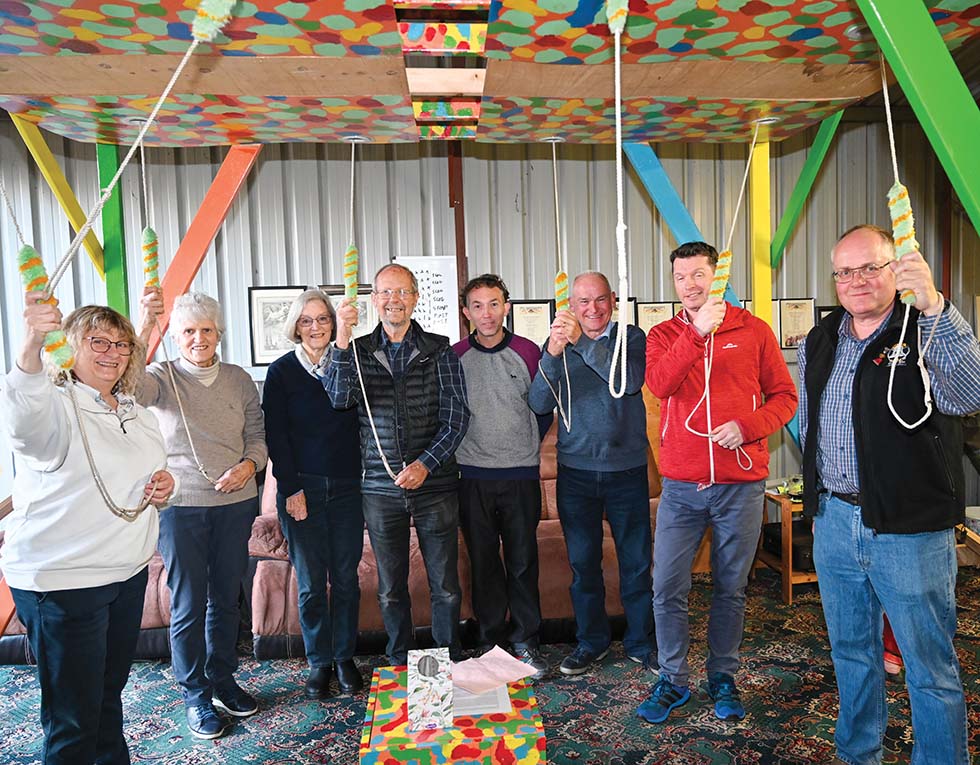

Corinne Rule and Adam Beer moved to Bridgetown around a year ago, the couple are experienced bell ringers. At different times they both have been in charge of ringing the bells in the Bell Tower in Perth. They are the owners of The Alphabet Ring bell setup which is housed in their shed on Roe Street.
The Alphabet Ring is a musical instrument like no other you will have seen. It is known as a mini-ring and consists of 8 bells tuned in a diatonic major scale of E flat.
The bells are rung using a rope and wheel. This is a small version of the church bells you would hear ringing for special occasions.
Most bells hung in this way are usually hung in church towers. There are also ‘civic towers’, such as the Bell Tower in Perth and the Civic Centre in Rockingham. Bells sets typically range from 5 to 12 bells.
The Bell Tower in Perth is unusual in being one of only three sets of bells in the world which have 16 bells in a musical scale.
The Alphabet Ring is the first privately-owned mini-ring in Australia, and indeed in the southern hemisphere. The bells were cast in the UK and exported to Australia in 2015 along with the wheels and bearings that enable them to be rung. The bell ropes were donated. Adam designed and built the frame housing the bells whilst they were living in New South Wales. There are 8 bells in the Alphabet Ring, the heaviest of which weighs just over 7kg.
Corinne and Adam moved from Kalgoorlie to Bridgetown because they wanted to live rurally and they also wanted somewhere to live that was close enough to Perth to ring on the bells with their friends at St. George’s Cathedral and Christ Church in Claremont.
Adam learnt the skill of ringing bells at the All Saint’s Church in Tuckingmill, a village named for its fulling mill (used to treat woollen cloth), in Cornwall England. Bell ringing was so much part of his life that before he left England to come and settle in Australia, he made sure there was a bell ring fraternity here. There is, it’s the Australia and New Zealand Association of Bellringers (ANZAB).
Adam talks enthusiastically about bell ringing, “The Alphabet Ring is a miniature version of bells hung for full-circle ringing, after the English fashion.
“Hanging bells in this way allows full control over when the bells strike, allowing for patterns or ‘methods’ to be rung. Tunes in the normal musical sense are not rung.
“The bells ring in sequence, but that sequence changes each time the bells are rung. The objective is to ring sequences which do not repeat in a given performance, which, depending on the length, may be called a ‘touch’, ‘quarter peal’ or ‘peal’.
“Each bell (rope) needs a bellringer who knows what they are doing and so to be able to demonstrate this properly we would need either 6 or 8 trained bellringers.
“When the bell ringing commences, we start with a descending scale, then we adjust our time, rhythm and speed to the ‘method’ we are using. Bell ringers have different ways of learning the sequences: after years of practice some can visualise the ‘method’, some use mnemonics as a way to remember.
“Recently we had bellringing friends visiting from Perth. On that weekend, the bell ringers took part in a ring of two previously un-rung ‘methods’ using half-muffled bells, in recognition of the passing of Queen Elizabeth II and the accession of the new King.
“Bell ringing for me is a passion, the larger the bell the more finesse is required. I have rung a bell which weighs around four tons, this come with its own danger: to ring a heavy bell you must stand on a box; if your stand on the ground the coiling and uncoiling of the rope around your feet can tangle around your legs hoisting you upside down into the air, leaving you bobbing up and down, which isn’t a pretty sight.”
Bell ringing, how hard could it be? As it turns out, it is not as easy as it looks. You pull the rope down until the bell is upside down and you hold it there, then on your turn, you pull the rope down, you let go of the rope, the bell strikes then when the rope reaches a point when the rope stops rising you hold the rope on the balance of the upside-down bell. The bell should only ring when it’s upside down and only strike the once on each pull, or so it should - only after months to years of practice.
This Story was published on November 1st 2022
In Issue 326 of The Mailbag
© The Quality Shop 125 Hampton Street Bridgetown Western Australia 6255
mailbag@thequalityshop.com.au